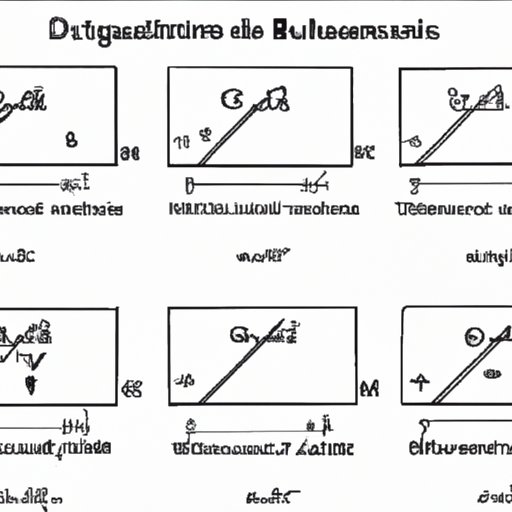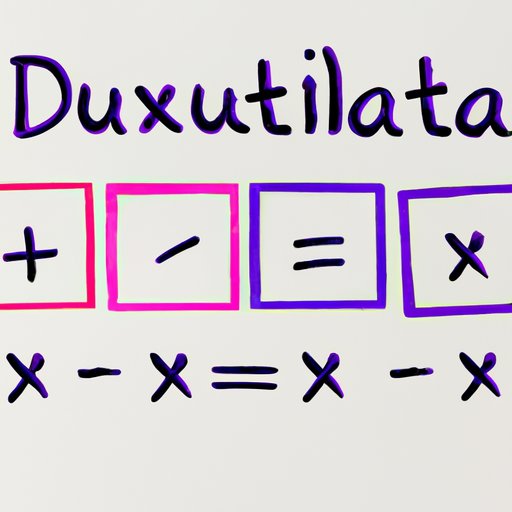I. Introduction
Discriminant is a vital concept in mathematics that is used to calculate the roots of a quadratic equation. It provides information about the nature of the roots and helps mathematicians solve complex equations. Understanding the discriminant can be a significant leap forward in comprehending mathematics as a whole.
II. Understanding the Basics: What is a Discriminant and How Does it Work in Mathematics?
A. Definition of discriminant: The discriminant refers to the mathematical expression under the square root sign in the quadratic formula.
B. The formula for discriminant: The formula to calculate the discriminant is b² – 4ac, where a, b, and c represent the coefficients of the quadratic equation ax² + bx + c = 0.
C. Explanation of discriminant function: The discriminant determines the type and number of roots of a quadratic equation. It helps mathematicians classify the equation as having two real roots, one real root, or two complex roots. It helps in determining whether the roots are rational, irrational, or imaginary.
D. Examples of how the discriminant is calculated: Consider the quadratic equation 2x² + 3x + 1 = 0. Here a = 2, b = 3, and c = 1.
The discriminant formula thus becomes discriminant = b² – 4ac = (3)² – 4(2)(1) = 9 – 8 = 1.
III. The Importance of the Discriminant in Solving Quadratic Equations
A. How the discriminant is used to find roots of quadratic equations: The discriminant helps find the roots of the quadratic equation using the quadratic formula x=(-b±√b²-4ac)/2a.
B. Importance of finding the discriminant before solving equations: Examining the discriminant before solving equations helps mathematicians know beforehand, the type of roots they should expect from the equation. It gives them an idea of the nature of the roots, whether they are rational, irrational, or imaginary.
C. Discussion of the different possible roots of quadratic equations based on the discriminant: If the discriminant is positive, a quadratic equation has two distinct real roots. If the discriminant is equal to zero, the equation has one real root. If the discriminant is negative, the equation has two complex roots.
D. Examples of how the discriminant is used in solving quadratic equations: Consider the quadratic equation 2x² + 5x + 2 = 0. Here a = 2, b = 5, and c = 2.
If we calculate the discriminant using the discriminant formula, we get:
Discriminant = b² – 4ac = (5)² – 4(2)(2) = 17
As the discriminant is positive, we know that the quadratic equation has two distinct real roots. We can then use the quadratic formula x=(-b±√b²-4ac)/2a to find the roots as follows:
x = (-5 ± √17)/4
Therefore, the two roots of the quadratic equation are (-5+√17)/4 and (-5-√17)/4.
IV. Applications of the Discriminant in Real Life Situations
A. Explanation of how the discrimination is used in different fields (physics, engineering, etc.): Discriminant has various applications in fields such as physics, engineering, and chemistry. For example, it is used when investigating the nature of systems with two degrees of freedom to determine the stability of such systems.
B. Examples of real-life situations where the discriminant is used: The value of discriminant is used to calculate the maximum height achieved by projectiles and to find the intersection points of tow curves in graph paper.
C. Importance of the discriminant in problem-solving: The discriminant is significant in problem-solving as it helps mathematicians regulate and understand unknown quantities and their properties by providing them with useful information about the nature of the roots.
V. The History of the Discriminant: How It Came to be Recognized as a Significant Mathematical Concept
A. Brief history of the discriminant: The discriminant was first attributed to ancient Greek mathematicians like Euclid and Diophantus. However, its use in the way we know of it today was not recognized until the 16th century.
B. People responsible for discovering the Discriminant formula: Simon Stevin, John Wallis, and Rene Descartes are credited with discovering the discriminant formula.
C. Explanation of how the discriminant formula evolved over time: Proposals to solve equations of the 3rd and 4th degrees forced mathematicians to refine the use of discriminant, which also helped improve the general understanding of mathematical concepts.
D. The modern-day significance of the discriminant: With advancements in technology and an increase in problem complexities, understanding the discriminant remains critical to problem-solving in various fields of study.
VI. Common Misconceptions about the Discriminant and How to Avoid Them
A. Common mistakes people make when calculating the discriminant: People may erroneously state the value of the discriminant based on the coefficients of the equation without realizing they need to plug the coefficients into the discriminant formula to derive its value.
B. How to avoid common errors when dealing with the discriminant: Use the discriminant formula to ensure accurate calculations. Cross-check results to determine their validity.
C. Explanation of common misconceptions: Some people may think discriminant is irrelevant or too complicated to use in problem-solving. It is a vital concept, and with repeated usage, it becomes relatively straightforward.

VII. Discriminants and Graphing Quadratic Equations
A. Explanation of how the discriminant can be used to determine the type of graph obtained by a quadratic equation: If the discriminant is positive, the graph of the quadratic will intercept the x-axis in two distinct points. A discriminant of zero gives a single intercept, and imaginary roots give a graph with no x-intercepts.
B. Examples of graphs of quadratic equations based on the discriminant: A quadratic equation with a discriminant value of 0 leads to a graph that just touches the x-axis. When the discriminant is negative, the graph neither touches nor intersects the x-axis. When the discriminant is positive, the graph will intersect the x-axis at two different values.
VIII. Calculating the Discriminant by Hand vs. With Technology: Pros and Cons
A. The advantages and disadvantages of calculating the discriminant by hand: Calculating by hand may be burdensome, but it helps improve accuracy. It also allows individuals to gain a clear understanding of the mathematical concepts involved in the calculation.
B. How technology can be used to calculate the discriminant: Technology can be used to solve complex equations involving discriminant quicker.
C. Comparison of different techniques of calculating the discriminant: Technology can be quicker and more efficient than hand calculations, but it may be less accurate. Hand calculations can take longer, but they provide a clearer understanding of mathematical concepts.
IX. Conclusion
A. Recap of the importance of understanding the discriminant in mathematics: Discriminant is a crucial concept in mathematics that helps to classify, find roots, and understand quadratic equations.
B. Key takeaways for the readers: Understanding the discriminant is critical in mathematics and helps improve accuracy and problem-solving skills.
C. Final thoughts on the topic: With the importance of mathematics in our daily lives, understanding the discriminant can help make life much easier. It is a concept that has evolved over time and remains relevant in various fields of study.
